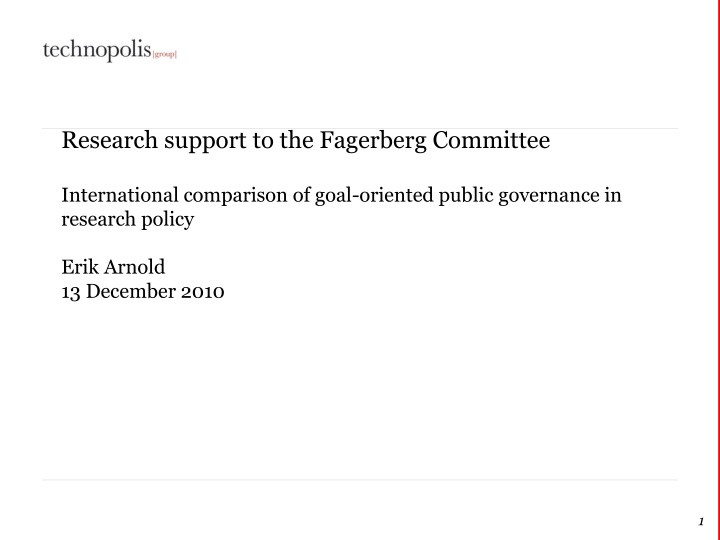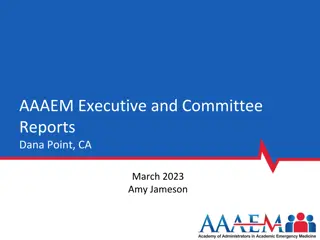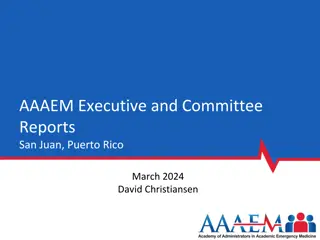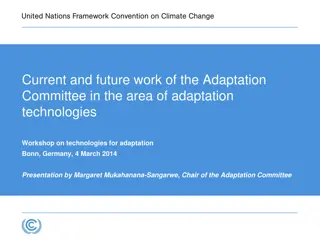Research support to the Fagerberg Committee
This research study conducted by the Fagerberg Committee examines the research systems and funding allocation in seven countries, focusing on efficiency, education, funding mechanisms, target monitoring, research production, and goal-oriented policy. The study emphasizes the dimensions of research policymaking, the role of ministries in research policy, and the diversity in research performing institutions among different countries.
Download Presentation

Please find below an Image/Link to download the presentation.
The content on the website is provided AS IS for your information and personal use only. It may not be sold, licensed, or shared on other websites without obtaining consent from the author.If you encounter any issues during the download, it is possible that the publisher has removed the file from their server.
You are allowed to download the files provided on this website for personal or commercial use, subject to the condition that they are used lawfully. All files are the property of their respective owners.
The content on the website is provided AS IS for your information and personal use only. It may not be sold, licensed, or shared on other websites without obtaining consent from the author.
E N D
Presentation Transcript
Research support to the Fagerberg Committee International comparison of goal-oriented public governance in research policy Erik Arnold 13 December 2010 1
Countries, questions The team has been busying itself with desk research to answer the study questions, for each of our seven countries Canada, Denmark, Finland and The Netherlands, New Zealand, Sweden and the UK The work has been organised around the seven topics listed in the study specification 1. Description of research systems and allocation of funding 2. Efficiency of the research performing sectors 3. Research education 4. Research funding mechanisms and criteria 5. Monitoring target achievement 6. Cataloguing research production 7. Successful goal-oriented research policy 2
Context Research policymaking at the overall level has three dimensions Development of a robust and dynamic research system comprising institutions able to produce knowledge and human capital of high quality and capability Identifying and breaking bottlenecks to the functioning of that system Enabling change, seizing new opportunities as these appear Requires A policy arena Distributed strategic intelligence Prospective study An explicit strategy is a useful organising device, but few countries have one 3
The research system - ministries At the level of government, countries face a choice between centralising research policy in a science ministry or decentralising it to the ministries as representatives of different sectors of society Among the countries studied, there is movement in both directions, though most favour decentralisation This creates a coordination problem, since many aspects of research and innovation policy transcend the responsibilities of individual ministries 4
The research system research performers Different countries make different choices about the shape and steering of research performing institutions Some maintain a strong research institute sector while others such as Denmark have moved away from this and increasingly integrate the institute research functions into the universities All use binary support systems for university research, but the balance between university block grants or institutional funding and research council funds varies widely In most of the countries considered, block grants are bigger than competitive funding only in the UK is the ratio the other way round 5
The research system three advice models A joint planning model (Japan), where the government uses the Council as a virtual horizontal ministry of innovation , much as engineering companies build project teams by bringing together people across different disciplines A co-ordination model (Chile, Finland, Netherlands Innovation Platform, to some extent Austria), where the intention is that the council should communicate horizontally across ministry responsibilities so as to align policies in support of innovation, without this alignment always being binding An advice model (Canada, Denmark, Ireland, Netherlands AWT, Sweden, Switzerland, UK), where the government is happy to be proactively or reactively advised on research and innovation policy but does not want to be restricted by that advice 6
Block grants dominate university funding (except UK) Index Uni Block Grants Research Councils Institutes/Labs CA 1.00 0.51 0.43 DK 1.00 0.59 0.06 FI 1.00 0.70 0.54 NL 1.00 0.33 0.53 NZ 1.00 0.38 0.22 SE 1.00 0.42 N/A UK 1.00 1.68 N/A 7
Shifting from GOVERD to HERD (as % of GDP) 100% 90% 80% 70% 60% 50% 40% 30% 20% 10% 0% CA98 CA08 DK98 DK08 FI98 FI08 NL98 NL08 NZ98 NZ08 NO98 NO08 SE98 SE08 UK98 UK08 EU15 EU15 08 98 HERD/GDP GOVERD/GDP 8
Research Council budgets are up but basic research is in relative decline (except UK) Basic Research 63% Applied Research Experimental development 9% Country / Segment DK Higher Education Year 1999 28% 2006* 55% 33% 12% DK Government 1999 30% 51% 19% 2006* 15% 63% 22% NZ Higher Education 1999 68% 32% 0% 2007 53% 28% 18% NZ Government 1999 53% 36% 11% 2007 40% 43% 17% NO Higher Education 2005 49% 36% 15% NO Government 2005 17% 61% 22% UK Government 2002 30% 54% 16% 2006 32% 53% 15% 9
Research efficiency universities and research funders We can find no systematic evidence that universities are becoming more administration-intensive This issue would require original research to explore further Research funders administrative costs appear to be flat or slightly declining, based on the numbers we have been able to collect 10
A range of funding instruments for doctoral training, increasingly dominated by graduate schools Funding Mode CA DK FI NL NZ SE UK As part of a project grant from an external funder, eg Research Council Funded from the university block grant X X X X X X X X X X Stipends competitively allocated by external funders to university departments Personal stipend X X X X X X X X X X Dual PhD training X X X X 12
Admission criteria for doctoral training Criteria: Block grant to institutions various combinations of capacity & quality measures (typically based on the same method used to allocate block research grants e.g. NZ bases doctoral allocation on same quality measure (PBRF) as block research grants) Competitive doctoral programmes UK: based on competitive grant income from each research council Finland: open competition review and selection by funding agency Doctoral applicant quality undergraduate relevance and performance, academic/ employer references, interview fairly standard approach across all countries 13
Research funding overview Objective: Quality and Impact of (publicly funded) Research Government R&D expenditure Funding source: Over-arching allocation method: Institutional core funding Project funding Capacity/ volume Quality e.g. quality of past research Quality e.g. quality of individual proposed research projects Impact e.g. potential impact of proposed research projects and/ or Criteria: Assessment method: Objective indicators e.g. no. of research staff Objective indicators e.g. no. of outputs bibliometrics Qualitative indicators e.g. Peer review Qualitative indicators Peer review Qualitative indicators Peer review 14
Performance Based Research Funding (PBRF) The sampled countries follow the international trend towards PBRF mechanisms Countries polarise between those that reallocate small (almost symbolic) amounts of money and those that drive the majority of institutional funding on the basis of performance There is a trend towards greater use of performance indicators especially publication and increasingly mechanistic ways of reallocating money Given the dangers inherent in such systems, they tend to apply in the cases where only small amounts of funding can be reallocated There is so far little evidence that PBRFs work, but some evidence that they can have perverse effects (eg Australia) 15
PBRFs Advantages and Drawbacks (Geuna & Martin) Advantages Drawbacks Performance-based meritocratic in that it links resources to performance, rewarding good research Strong incentive to improve individual as well as institutional performance Competition may lead to increased efficiency ineffective research identified and cut Encourages research to be properly completed and written up for wider dissemination Provides public accountability for government funds invested in research Encourages more explicit/coherent research strategy on part of department or institution Provides mechanism for linking university research to government policy (e.g., to shift priorities) Concentration of resources may enable best departments to compete with world leaders (e.g., in US) High cost and labour intensity (whether peer review or indicator-based) for universities and evaluating agencies May cause homogenization of research and universities i.e., decrease in diversity and experimentation May discourage more innovative and risky research Encourages publication inflation (e.g., salami publishing ) and other game playing (e.g., with indicators) i.e., looking good rather than necessarily doing better May encourage traditional academic research at expense of research linked to society s needs Tends to separate research from teaching, implying lower priority for teaching Rewards past performance not current or future potential Reinforces research elite/status quo may cause overconcentration May lead to excessive government influence/ interference in university 16
Lessons from wider international experience with PBRFs Move slowly enough to let the system respond to the changed incentives Take small steps moving small amounts of money has big effects on behaviour Explicitly tackle field differences Do not use solely indicator-based approaches but combine these with other allocation principles Pilot the system before using it 17
Monitoring target achievement Performance contracts are increasingly used in steering agencies and research performing institutions Performance indicators used do not conform to a single standard but tend to be developed ad hoc for each contract A surprising proportion of such indicators relate to processes rather than outcomes and impacts, which is perhaps an important reminder of just how hard it is to develop meaningful indicator systems for the latter At a lower level, project performance is increasingly being monitored, providing agencies with opportunities better to understand the activities of their beneficiaries and to consider the degree to which progress is being made towards programmatic and institutional goals 18
Cataloguing research outputs A key problem for the assessment component of PBRF systems is language, since the bibliometric indexes have a bias towards English Such systems need also to handle the fact that many scholars, especially outside the hard sciences, use channels such as books and monographs that are invisible to journal-based bibliometrics Some countries have begun to catalogue national research outputs, in support of a PBRF system. Without a PBRF, there seems little point in doing do This seems to be necessary where research is published in small languages and in order to take proper account of the social sciences and humanities in mechanical systems 19
Goal-oriented public policy Growing use of targeting and performance contracting, driven by the New Public Management Careful analysis of intervention logics is needed, preferably using logic charts Design dilemma: counting things that don t matter versus counting things that matter but can only be influenced Use of multi-layered performance goals is rare (NZ) but may be useful in combination with an explicit strategy (Chile Goal orientation does not replace the need for coordination and decentralised intelligence 20
Thank you technopolis |group| has offices in Amsterdam, Ankara, Brighton, Brussels, Frankfurt/Main, Paris, Stockholm, Tallinn and Vienna 21 21























